
ICCROM_03_PublicAdvocacy_en
.pdf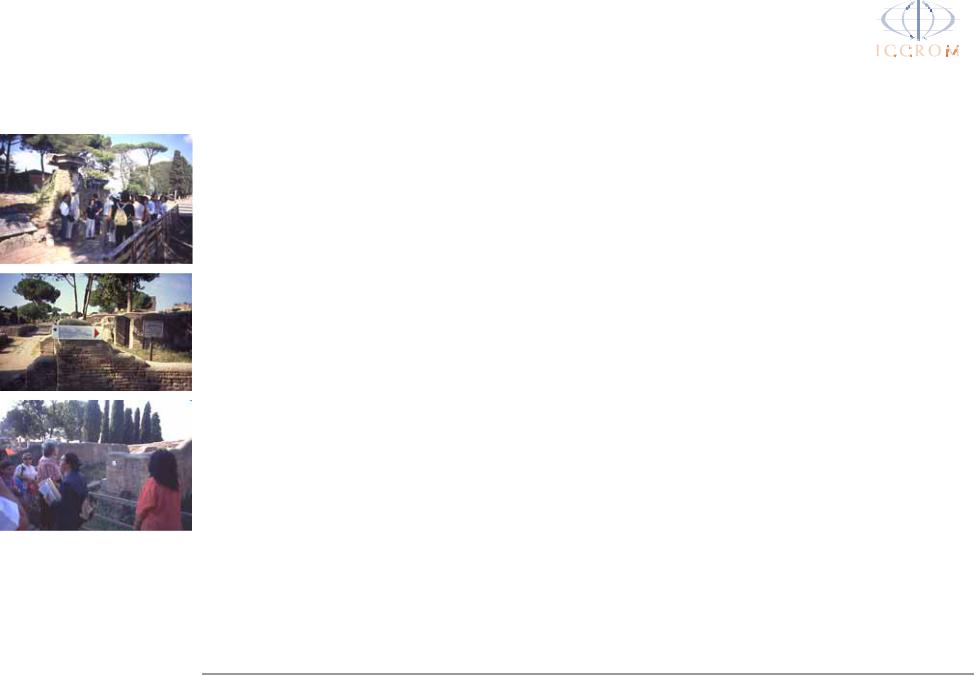
I C C R O M a n d P u b l i c A d v o c a c y : I C C R O M P r o j e c t s : A d u l t s
2) Tour: Suggested Steps
Before the project
•Establish your timeline. Allow four to six months for the entire tour project.
•Choose a site that manifests conservation problems that you want to highlight to the public. For instance, at an archaeological site you could highlight damage to floor mosaics from the roots of overgrown vegetation, or the blackening of mosaics due to microorganisms, among many other possibilities.
•Establish key partnerships with the site or museum, the appropriate levels of government, scientific experts. Establish organizational committees.
•Set out a tour around the site, including a variety of stops that illustrate a number of different environmental conservation problems.
•Design and print a leaflet. It should explain the purpose of the tour, provide both historical and artistic information about the site, and include the tour map. Each stop should include a brief description of the environmental damage detected, the conservation efforts undertaken, the costs involved, and the duration of the project.
•Organize a training course for tour guides at the site or museum. Encourage tour guides to highlight conservation issues as often as possible during their tours. Provide them with relevant further references to give to interested visitors.
•Organise a series of visits with prepared tour guides. Consider inviting school groups, employee groups from large companies, or other groups of the general public to participate. Consider arranging a tour for a group of media professionals. (See Further References for a guide to working with the media.)
•Develop a post-tour questionnaire for tour participants. Include the questionnaire in the tour leaflet.
•Put up easily identifiable numbered signposts at each tour stop.
During the project
•Distribute the leaflet and questionnaire to all visitors.
•Record the number of visitors who take the tour.
Follow-up
•Collect and analyze questionnaire data.
•Organise regular training courses for tour guides, including conservation issues.
•Continue to highlight conservation issues at the site via public communications tools, such as on tickets, other printed material, posters, information panels, website, books at the bookstore, and so on.
Prepared by Naomi Grattan. © ICCROM 2004
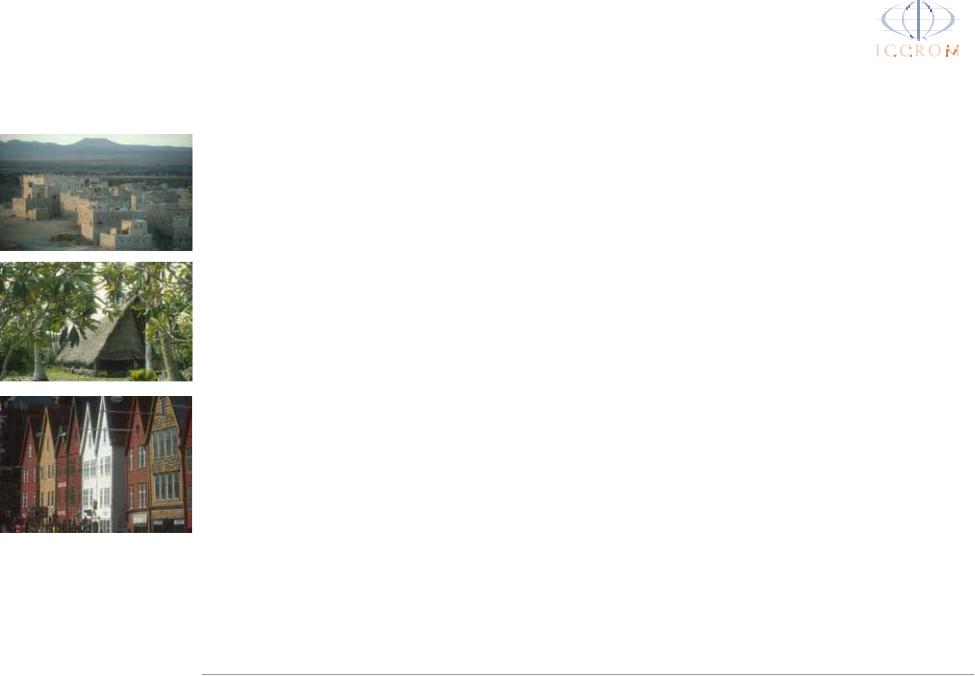
I C C R O M a n d P u b l i c A d v o c a c y : F u r t h e r R e f e r e n c e s
Background: Cultural Heritage and Public Advocacy
What is Cultural |
|
Today these distinctions are made |
improves mutual comprehension |
and |
||||||||||||
Heritage? |
|
|
primarily for legal requirements. |
|
helps develop policies for peace. |
|
||||||||||
Cultural heritage is the creative |
While there is much institutional |
“Too often, ignorance of each |
||||||||||||||
expression of people’s existence in the |
support for the protection of tangible |
other’s ways and lives has been |
||||||||||||||
past, near past, and present. It tells us |
heritage, to date there has always been |
a common |
cause, |
throughout |
||||||||||||
detailed stories about the traditions, |
less available for the protection of |
history, of that suspicion and |
||||||||||||||
beliefs, values, lifestyle, behaviour, and |
intangible heritage. However, it is |
mistrust among people... which |
||||||||||||||
the achievements of a region and its |
becoming |
increasingly |
apparent |
that |
leads to war.” |
|
|
|
||||||||
people. The development of cultural |
intangible heritage must be protected |
- Preamble, UNESCO’s Constitution |
||||||||||||||
heritage |
depends |
on our abilities as |
to the |
same |
degree |
as |
tangible |
It strengthens |
economies. Cultural |
|||||||
human beings to learn and to share our |
heritage, as the two aspects of cultural |
|||||||||||||||
heritage is also |
a source |
of economic |
||||||||||||||
knowledge with |
succeeding |
gene- |
heritage |
are |
inextricably |
linked. |
||||||||||
development, particularly |
for |
tourism, |
||||||||||||||
rations. |
|
|
|
Without |
an |
understanding |
of |
the |
||||||||
|
|
|
which encourages the growth |
of |
local |
|||||||||||
Cultural |
heritage |
consists of |
two |
intangible cultural context in which an |
||||||||||||
arts and crafts |
industries, and |
other |
||||||||||||||
object was |
created, the object |
itself |
||||||||||||||
interrelated subject areas: |
|
tourism-related activities. |
|
|
|
|||||||||||
|
loses much of its inherent meaning. |
|
|
|
||||||||||||
|
|
|
|
|
|
|
|
|
||||||||
•Intangible heritage: which refers to music, dance, literature, languages, theatre, and other immaterial cultural objects.
•Tangible heritage: which refers to material items such as buildings, artworks, objects, and statues. Occasionally tangible materials are further broken down into Immovable and Movable objects. Immovable objects – items that cannot be physically moved – include monuments, archaeological sites, historic centres, cultural landscapes, gardens and parks. Movable objects include private and public collections, libraries, and archives.
Why protect Cultural |
It is unique. Cultural heritage is |
||||||||||||
unique and irreplaceable; once it has |
|||||||||||||
Heritage? |
|
|
|
disappeared it is gone forever. |
|
||||||||
It |
conveys |
messages. |
Cultural |
It is fragile. Cultural heritage may |
|||||||||
heritage is important for many reasons. |
seem eternal, but it is not. It is fragile; |
||||||||||||
It tells us about the historical, artistic, |
it will not last forever. We must |
||||||||||||
aesthetic, |
political, |
religious, |
social, |
maintain and preserve the cultural |
|||||||||
spiritual, scientific, and natural values |
heritage of the past, and present, so it |
||||||||||||
of a particular geographical region and |
will be available to people in the future. |
||||||||||||
its people. These values gave meaning |
It |
is under |
attack. |
Whether |
we |
||||||||
to the lives of people who came before |
|||||||||||||
recognize it or not, every day cultural |
|||||||||||||
us, |
and so they transmit meaning to |
||||||||||||
heritage suffers attacks |
from |
both |
|||||||||||
our own. |
|
|
|
|
|||||||||
|
|
|
|
environmental |
and |
human |
sources, |
||||||
It |
promotes |
understanding. The |
|||||||||||
some have immediate effects, and |
|||||||||||||
cultural heritage of a particular group |
others are only evident after long |
||||||||||||
of people represents their unique |
periods of time. Both have the same |
||||||||||||
identity. Understanding the values of |
result: a combination of environmental |
||||||||||||
different |
social |
and |
cultural |
groups |
and |
human |
causes |
are |
destroying |
||||
cultural heritage worldwide right now.
Prepared by Naomi Grattan. © ICCROM 2004
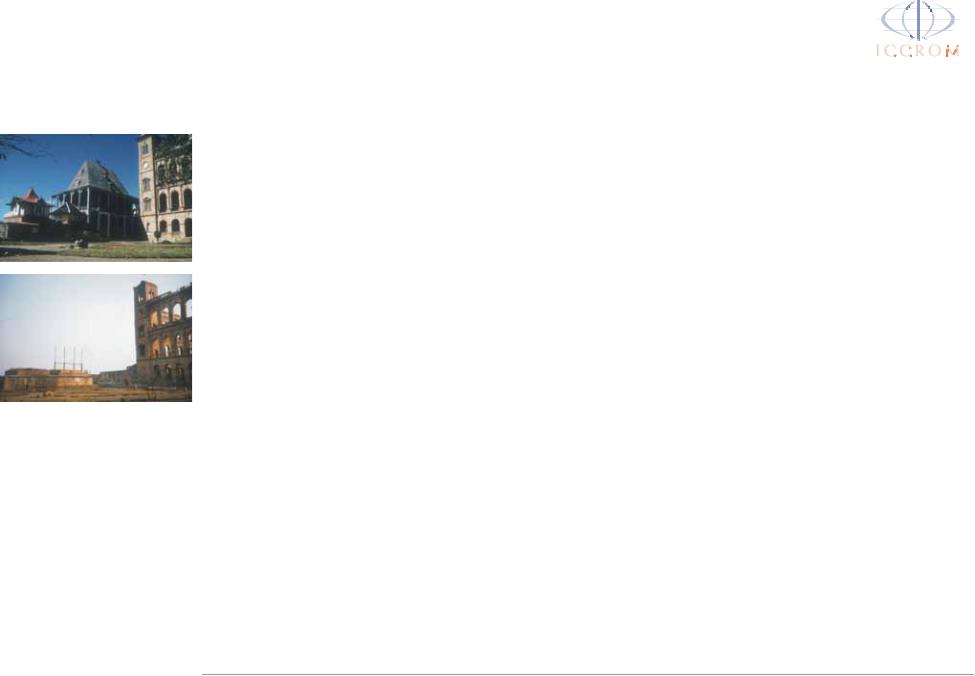
I C C R O M a n d P u b l i c A d v o c a c y : F u r t h e r R e f e r e n c e s
Background: Cultural Heritage and Public Advocacy
Environmental threats include: climate, natural disasters, light, and animals. Human threats include: pollution, wars, vandalism, neglect, lack of legislation, illegal digging, and urban development, among others. (For a detailed list see the Further References section.)
How is it protected?
Cultural heritage is chiefly protected by trained professionals in three ways: conservation, restoration, and education.
Conservation refers to a series of actions undertaken to slow deterioration of both environmental and cultural heritage. Professionals employ two types of conservation activities:
1.Preventive conservation, which comprises various activities undertaken to delay the eventual deterioration of an object before serious problems develop. For example: climate control, environmental monitoring, and biocide treatment to prevent insect attack.
2.Curative conservation, which comprises a specific
activity to ensure the survival of an object when its structural integrity is threatened. Consolidating a tottering wall, disinfesting a wooden statue, or
removing vegetation from ancient walls, are all examples of curative conservation.
Restoration is a direct treatment to facilitate the legibility and understanding of a seriously damaged work of art. Sometimes it is necessary to ensure the survival of an object. For example, treating a lacuna, glueing broken shards of pottery together, replacing missing pieces of an architectural structure, and so on. Restoration is frequently traumatic to objects, and so it is preferable to prevent initial damage rather than to restore objects afterwards.
Education. The success of professional conservation activities depends on the conscientious behaviour of individuals. No matter how large or small, every heritage, educational, cultural, and civic organization can contribute to the preservation of the world’s cultural heritage. Raising public awareness is the key to preventive conservation, and to mobilising public support – and therefore political support – for conservation activities.
Cultural heritage organizations face an enormous challenge: balancing public use and interest against the needs of preserving heritage for the future. Why spend money conserving an object or a site, if no one is interested in it, or allowed to see it? The aim of
conservators is therefore not only to preserve cultural property, but also to create the best conditions in which it can be used and learned from, while maximizing its lifespan.
If the general public understand cultural heritage belongs to them as well as the State, and they understand that they can contribute to its conservation, then basic preventive conservation practices undertaken by the public will complement professional activities, and much deterioration of cultural heritage can be deferred.
Why involve the public?
Because cultural heritage belongs to the public.
Obviously who we are and how we live rests on the cultural foundations of people who came before us. Today, Cultural Tourism is one of the fastest growing tourism markets; people are genuinely interested in not only their own cultural heritage, but also the heritage of the rest of the world. The related increase in the volume of tourist traffic is a cause for increasing concern, because heavy tourist traffic, combined with vandalism, ignorance, the sale of cultural artifacts, and other human failings take an extremely high toll on cultural heritage around the world.
Prepared by Naomi Grattan. © ICCROM 2004
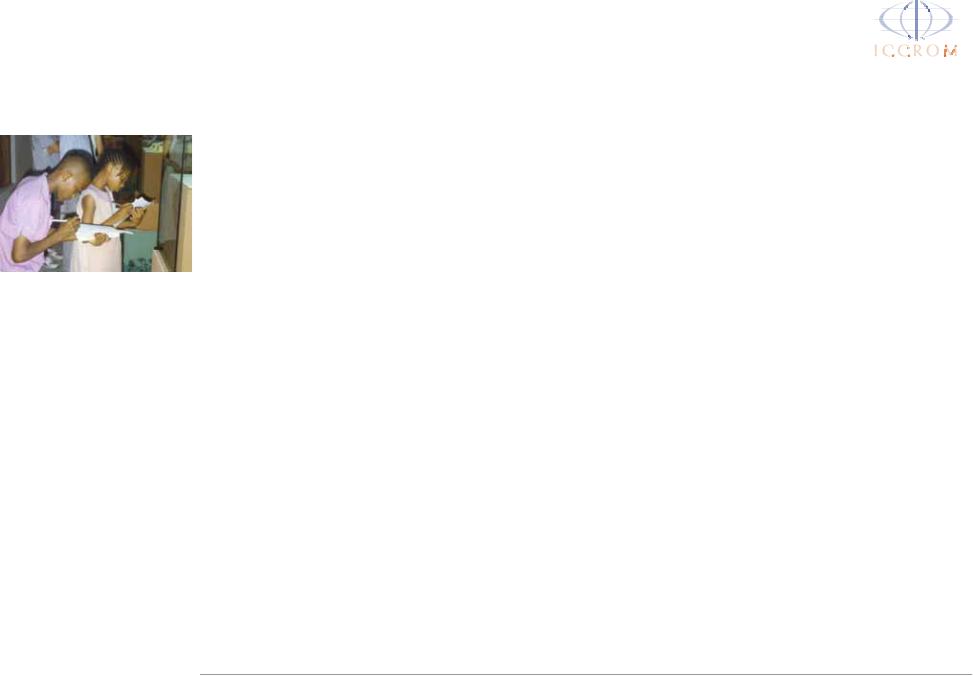
I C C R O M a n d P u b l i c A d v o c a c y : F u r t h e r R e f e r e n c e s
Background: Cultural Heritage and Public Advocacy
In the last century, cultural heritage belonged mainly to private individuals. Private ownership meant that most cultural property was well maintained: maintenance costs were relatively low, and there were relatively fewer causes of deterioration. Tourism had yet to become the global industry it is today, and so traffic at heritage sites was minimal. Today, however, most cultural heritage belongs to public institutions, and people are collectively responsible for its conservation.
Because it must be protected.
To be successful in achieving a balance between public use and the conservation of cultural heritage, the public and conservation professionals must work together. The public must support the efforts of conservators, and conservators must educate the public – how they can help, and why conservation is important. Simply explaining museum restrictions goes a long way to changing human behaviour. Only together can we, the present inheritors of the world’s cultural heritage, successfully transmit both the past, and the present, to the future.
How is public awareness raised?
Raising public awareness means engaging the public’s attention to
create a strong collective understanding about a particular subject. Generally, raising public awareness is achieved through the media: newspapers, the Internet, television, magazines, and so on. It can also be achieved by developing advocacy activities (such as those of ICCROM) for specific target groups. Every activity designed to raise public awareness will reach a broader audience when its scope is enlarged with even the most basic media relations strategy (see
Further References for a brief guide to working with the media).
Increasing public awareness about the conservation of cultural heritage can also be achieved by providing just a bit more information than is usually available on standard panels in museums and at heritage sites, and by encouraging the public to become involved in, and so feel responsible towards, conservation efforts. For example:
•Clarify restrictions and regulations. Explain why touching an object is harmful, why items are enclosed in glass cases, or are roped off, and so on.
•Explain the causes of deterioration.
•Reveal conservation efforts at work and highlight the results.
•Request help with conservation efforts, by advising people of appropriate behaviour.
•Share information about the realities of conservation and maintenance, such as costs and the length of time involved.
•Open restoration workshops to the public.
Regardless of the method, getting the public involved by actively engaging their interest is the most effective way to educate people. People will not change their behaviour unless they understand the impact they have, and how they can contribute to the conservation of cultural heritage.
Prepared by Naomi Grattan. © ICCROM 2004
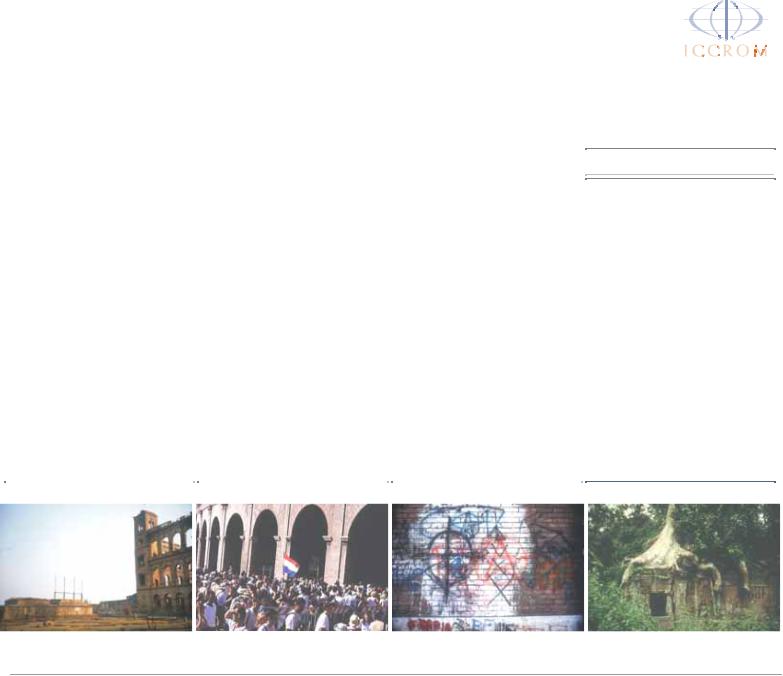
I C C R O M a n d P u b l i c A d v o c a c y : F u r t h e r R e f e r e n c e s
The Causes of Deterioration of Cultural Heritage
|
|
|
|
|
|
|
|
|
|
Immediate & Drastic Effects |
|
Slow & Cumulative Effects |
|
||||
|
|
|
|
|
|
|
|
|
|
|
|
|
|
|
|
|
|
|
Natural Causes |
|
Human Causes |
|
Human Causes |
|
Natural Causes |
|
|
|
|
|
|
|
|
|
|
|
|
|
|
|
|
|
|
|
|
earthquake |
|
fanaticism |
|
abrasion |
|
birds |
|
|
fire |
|
illegal excavation |
|
graffiti |
|
climate |
|
|
flood |
|
illegal trade |
|
ignorance |
|
corrosion agents |
|
|
hail |
|
modern ploughing |
|
neglect |
|
dissolved salts |
|
|
hurricane |
|
public works |
|
treasure hunting |
|
dust |
|
|
lightning |
|
terrorist attack |
|
vibration |
|
erosion |
|
|
storm |
|
theft |
|
visitor affluence |
|
humidity |
|
|
tidal wave |
|
tourism |
|
|
|
insects |
|
|
volcanic eruption |
|
urban development |
|
|
|
light |
|
|
|
|
vandalism |
|
|
|
micro-organisms |
|
|
|
|
war |
|
|
|
pollution |
|
|
|
|
|
|
|
|
rodents |
|
|
|
|
|
|
|
|
temperature |
|
|
|
|
|
|
|
|
vegetation |
|
|
|
|
|
|
|
|
|
|
|
|
|
|
|
|
|
|
|
Prepared by Naomi Grattan. © ICCROM 2004
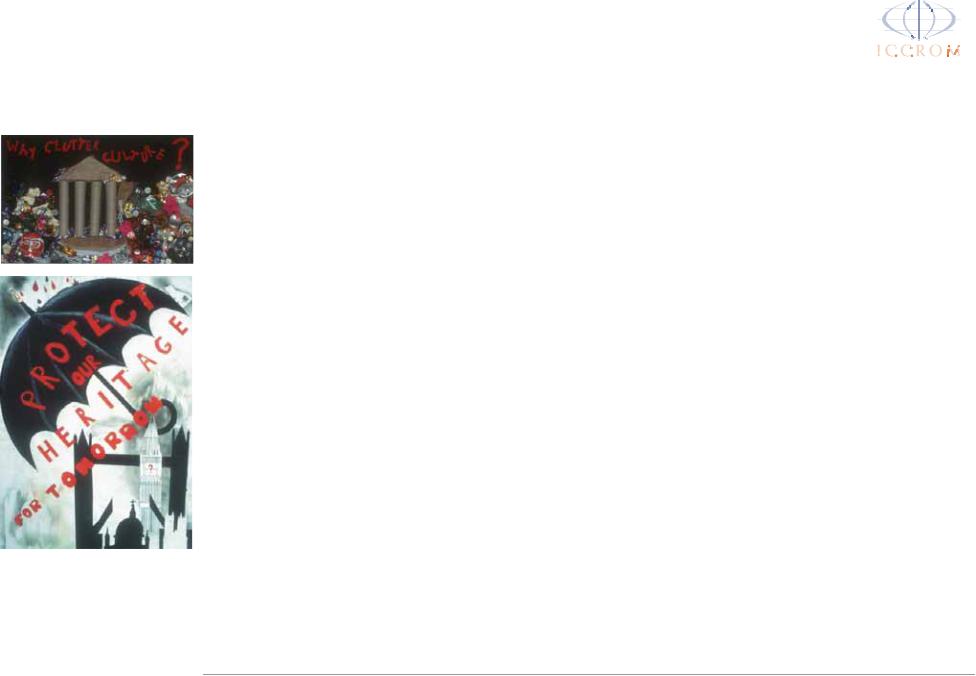
I C C R O M a n d P u b l i c A d v o c a c y : F u r t h e r R e f e r e n c e s
Suggested Reading and Web Resources
Suggested Reading
•Ardemagni, Monica, Giuseppina Fazio, Annamaria Pandolfi, e M. Laurenzi Tabasso. Stop al
Vandalismo Grafico. Proposta per una Campagna di Prevenzione.
Comune di Roma, 1996.
•Basile, Giuseppe. Les enfants peuvent aussi contribuer à la sauvegarde des oeuvres d’art. In:
Cahiers d’étude, 1995.
•Dathy, Isabelle. La conservationrestauration du patrimoine et la médiation culturelle. In: La lettre de l’OCIM, 2003.
•Gesché, Nicole et Catheline Périer-
D’Ieteren. Patrimoine et sensibilisation. In: Les nouvelles du patrimoine, 2000.
•ICCROM, The Council of Europe.
The City Beneath the City.
ICCROM, Rome, Italy; Council of Europe, Strasbourg, France; 1995.
•ICCROM, UNESCO. Introducing
Young People to Heritage Site Management and Protection: A practical manual for secondary school teachers in the Arab Region. ICCROM, Rome; UNESCO, Paris, in press.
•ICCROM, UNESCO. Media Save Art Award 1991. ICCROM, Rome; UNESCO, Paris, 1991.
•ICCROM. The Press and the
Safeguard of Heritage: A collection of press articles on the subject of the fragility of cultural heritage and its conservation.
ICCROM, Rome, 2000.
•ICCROM. Youth and the
Safeguard of Heritage: Approaches to raising youth awareness of the fragility and the conservation of cultural heritage.
ICCROM, Rome, 2000.
•Jolly, Pieter. Conservation of rock art in Lesotho, southern Africa: A project to educate primary school children concerning the need to preserve San rock paintings. In:
International newsletter on rock art, 2003.
•Kaldun, Beatrice (comp).
Southeast Asian World Heritage in Young Hands: A workshop on the introduction and evaluation of the UNESCO World Heritage Education, Sukhothai, Thailand 2000. UNESCO, Principal Regional Office for Asia and the Pacific, Bangkok, 2000.
•Lerber, Karin von. De la conservation à la sensibilisation: l’aménagement des sacristies avec la collaboration des bénévoles. In: Regards sur le
patrimoine religieux: de la
sauvegarde à la présentation. Actes du colloque, Bourg-en-Bresse Belley, 30 septembre - 2 octobre 1999. Barruol, Agnès (ed), Billat, Monique (ed), Penez, Catherine (ed). Actes Sud, Arles, 2000.
•Museums & Galleries Commission.
Ours for keeps? A resource pack for raising awareness of conservation and collection care. (Revised ed). Museums & Galleries Commission, London, 1998.
•Nardi, Roberto. Going Public: A new approach to conservation education. In: Museum International, 1999.
• Pandolfi, |
Annamaria. |
La |
|
conservazione |
del |
patrimonio |
|
monumentale: |
Il |
Vandalismo |
|
Grafico. Ministero per i Beni e le Attività Culturali; Istituto Centrale del Restauro; Rome, 2000.
•Pendlebury, John and Tim Townshend. The Conservation of
Historic Areas and Public Participation. In: Journal of architectural conservation, 1999.
•Périer-D’Ieteren, Catheline (ed).
Public et sauvegarde du
patrimoine: |
cahier |
de |
sensibilisation |
à l’intention |
des |
guides. Centre de recherches et d’études technologiques des arts
Prepared by Naomi Grattan. © ICCROM 2004
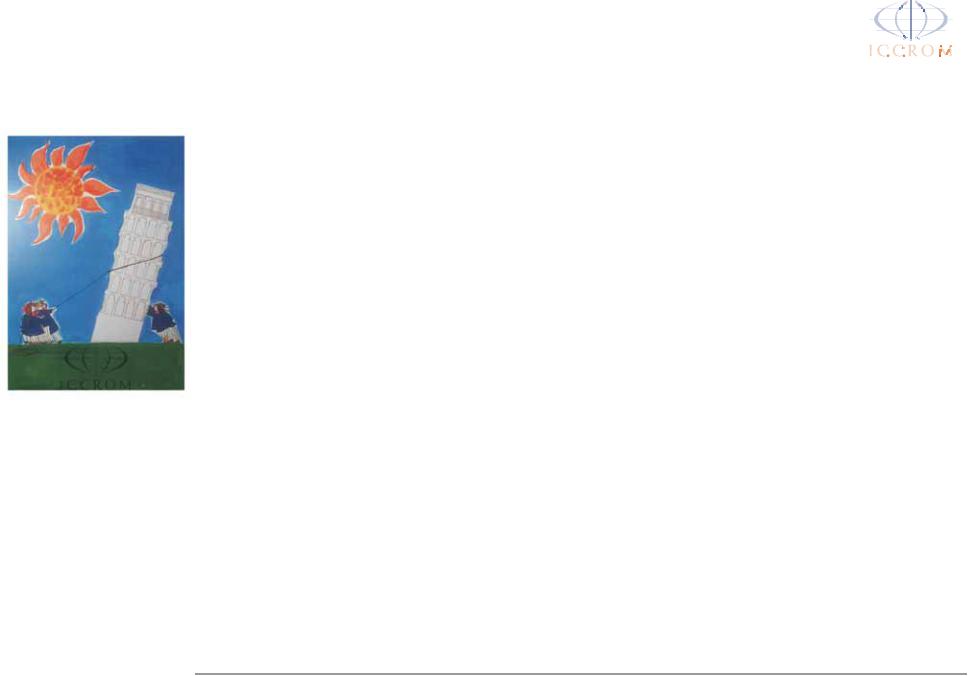
I C C R O M a n d P u b l i c A d v o c a c y : F u r t h e r R e f e r e n c e s
Suggested Reading and Web Resources
plastiques, |
Université |
libre |
de |
|
Bruxelles, 1999. |
|
|
|
|
• Posnansky, |
|
Merrick. |
The |
|
Archaeologist and the Comm- |
||||
unity: Commitment, |
Awareness, |
|||
and Cultural |
Identity. |
In: |
||
Archaeology |
and |
safeguarding |
of |
|
heritage: proceedings |
of the |
6th |
||
colloquium, Cotonou, Benin, 28th March–2nd April 1994. Adande, Alexis B.A. (ed), Bagodo, Obaré (ed). West African Archaeological Association (WAAA), 1994.
•Pye, Elizabeth. Caring for the
Past: Issues in Conservation for Archaeology and Museums. James & James, London, 2001.
•San Martín, Concha, Manuel Ramos, Immaculada de la Torre, & Manuel Morales. Sensibilizar para conservar: una experiencia con público infantil en un museo arqueológico. In PH: boletin del Instituto Andaluz del Patriomonio Histórico, 2001.
•Stanley-Price, Nicholas (ed).
Historical and Philosophical Issues in the Conservation of Cultural Heritage. Getty Centre for Education in the Arts, Los Angeles, 1996.
ICOM-CC, ICA-AVICOM, Paris; CRE Mogliano Veneto. ICCROM, Rome, 1998.
•UNESCO. World Heritage 2002:
Shared Legacy, Common Responsibility. An international congress, Venice 14-16 November 2002. Report. World Heritage Centre, UNESCO, Paris, 2003.
•UNESCO. World Heritage in
Young Hands: To know, cherish and act. An educational resource kit for teachers. UNESCO, Paris, 2002.
•Verma, D.N. Conservation and
Public |
Awareness. |
In: |
|
Conservation, |
Preservation, |
and |
|
Restoration: |
traditions, |
trends |
and |
techniques. |
Kamalakar, |
G. |
(ed), |
Pandit Rao, V. (ed). Archaeological & |
|||
Cultural Institute, Birla, |
Hyderabad, |
||
1995. |
|
|
|
Web Resources
•Australian Heritage www.heritage.gov.au
•Canadian Heritage Information Network www.chin.gc.ca
• Tonon, Marco (ed). Conservation |
• Canadian Heritage |
is – est participation. ICCROM, |
www.pch.gc.ca |
Rome; Istituto per il Restauro, Rome; |
|
•English Heritage www.englishheritage.gov.uk
•English Heritage Archaeology www.english-h.gov.uk
•International Centre for the Study of the Preservation and Restoration of Cultural Property
www.iccrom.org
•International Council of Museums www.icom.org
•International Council on Monuments and Sites www.icomos.org
•Norwegian Agency for Development Cooperation: www.norad.no
•United Nations Education and Scientific Organization www.unesco.org
•Virtual Heritage Network www.virtualheritage.net
•World Heritage Centre http://whc.unesco.org
•World Heritage Centre List http://whc.unesco.org/ heritage.htm
Prepared by Naomi Grattan. © ICCROM 2004
